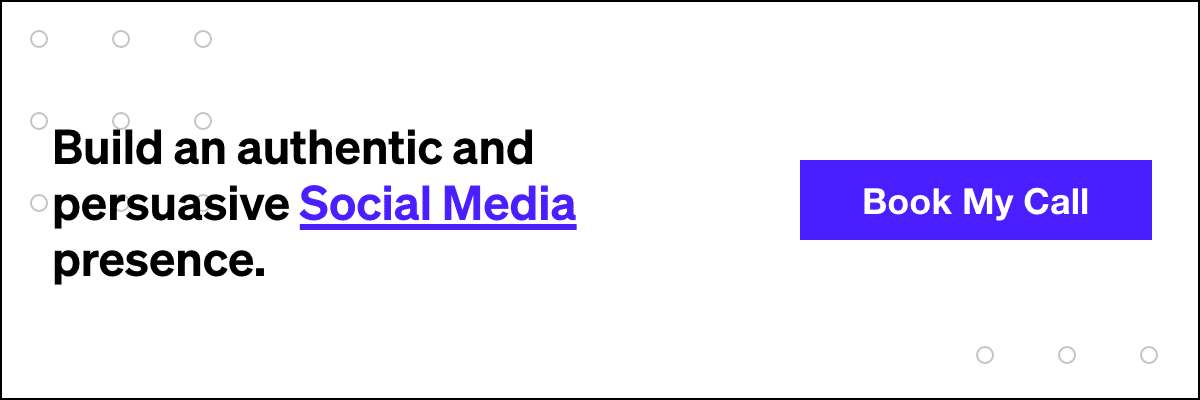Month 1 of a partnership with a brand is debatably the most important and time-consuming work you will do because it is where all of the heavy lifting takes place. If you don’t start off on the right foot, the relationship could tarnish in the weeks and months to come. That’s why the onboarding process needs to be thorough, well organized, and executed flawlessly in a timely manner.
In regards to social clients, an in-depth social analysis is a strong way to hit the ground running with an outline of your strategy and the reasons behind it. It is also the perfect opportunity to gain valuable feedback before executing on your strategy. In this blog post, you will find a few important questions to ask your new client right off the bat, followed by the main points to include in an in-depth social analysis.
Important Questions To Ask
1. Who are your top direct and indirect competitors?
This will indicate what social profiles to analyze and allow you to better understand the industry that you will now be entering and posting within. You will then be able to measure against the competition, see where there is room for improvement, and possibly build off of another brand’s strategy to become bigger and better than the rest.
2. What is your brand’s voice?
Your job is to post on your brand’s social pages using the brand’s unique voice. This will also be incredibly important for when you engage with the brand’s audience. You want to speak in that voice as consistently as possible. Therefore, understanding the brand’s voice and personality is essential to your future posts. This is also the perfect time to ask what do’s and don’t’s the client may have. For instance, do they like to use the verbiage “cheap” or do they prefer to be thought of as high-end.
Related: Strategies for Growing Your Social Media Following as a New Brand
There is also the potential that the brand does not have a set voice or personality yet. Maybe that’s why they came to you in the first place. If that is the case, this allows you to gather some information and come up with options to fill that gap.
3. What brands do you think are doing a great job on social?
This will give you insight into what your clients like and don’t like on social. Everyone has a particular taste, so discovering their preference will help you when creating the visual imagery for the brand.
4. What is your main goal for your social media channels?
Higher engagement, an increase in reach, brand awareness, conversions? This is crucial to understanding before starting a content calendar. Not only could this completely change your strategy, it’s also important for setting clear expectations for both you and the client. If the goals are unrealistic, you’ll need to communicate that and set realistic expectations that still align with their main goal. This will help you avoid problems down the road because you will then know what you are expected to achieve and thus what you should measure.
Creating A Social Analysis
Facebook’s Audience Insights Tool allows you to enter various interests and pages that align with your brand, as well as ages, locations, languages, financial incomes, job titles, and much more. You can get as broad or as narrow as you would like when choosing this target audience. Once all of your key search criteria has been entered, you will want to surf through all of the given information in order to firmly grasp who your brand’s potential target audience may be and their behaviors. This will give you a guide in creating your strategy specific to who your audience is.
The first slide of your social analysis will depict your primary and secondary audiences. As important as it is to relay this information, you’ll also want to offer key takeaway points for your client. For instance, if you state that the primary audience consists of men and women ages 25-44, how will your strategy piggyback off of this information? How does this information relate to the brand and to social media behaviors in general? Do not just state, elaborate.
After an overview of the audiences, you can display the graph showing the specific percentages of each, shown in the image above, as well as what interests you plugged in to get those results. This gives the client the actual Facebook numbers for them to reference as needed. It will also increase your credibility and foster your relationship with them as an expert.
Related: Are My Target Customers on Social Media?
Following this, a few important charts to screenshot and insert into your analysis are pages liked, social engagement habits, employment, purchase habits, and home ownership and income. If the client’s main goal is revenue, you can also add the retail vs. online spending charts to offer them insight on how your audience usually spends money and if revenue from social is likely or unlikely.
- Pages Liked: This displays what your audience is interested in on social platforms. Do they tend to follow pages similar to yours? Are they likely to be interested in your page? Gaining as much information on your audience as possible can only help in viewing social media from the consumers point of view and then pivoting your strategy accordingly.
- Social Engagement Habits: This chart will display how likely your audience is to like pages, comment & like posts, share posts, and click on ads. This will help you and the client in setting standards based on your audience. For instance, if your audience is not likely to like pages, you can explain that to the client so that you both understand that gaining page likes may be more difficult. You could then suggest creating a boosted budget in order to meet that need or simply understand that it might be a slow growth.
- Employment: Your audience could be filled with a wide mixture of occupations or it could be filled with titles that are not typical 9-5 jobs. Not only will this help you understand what time to post your content, but also what this audience may need or value. It can also offer insight into how dependable their income is, thus outlining if they can be a consumer or not. Lastly, understanding their particular fields could help in strategizing. For instance, if you are selling children’s toys and your target audience is filled with people in the education industry, you can target your messaging to them through back to school sales, etc.
- Purchase Habits: Where is the bulk of their money going? Are you already part of their spending habits or will you have to build brand awareness in order to cause conversions down the road? These are all very important things to consider before executing your strategy. With the bottom line always in mind, your client will appreciate this inside information as well.
- Home ownership and income: Homeownership and home value may or may not directly pertain to your client. However, income does. Learning where their annual income lies will help guide your language, messaging, and promotional campaigns.
Competitive Analysis
Next, you’ll want to review your analysis of 1-3 direct competitors. After diving into each competitor’s social platforms, record their audience size in order to understand how large their social followings are and what platforms they leverage the most. A few key things you’ll want to look at are:
- How strong is their social presence?
- Are they highly active and responsive to their audience?
- Do they have strong imagery and/or video content?
- What is their social strategy?
- Are they properly optimizing their posts?
- Do they have a mixture of different types of posts?
Related: Social Media Marketing Strategies for Lead Generation & E-Commerce
The potential list of questions goes on and on and can differ by each brand. However, by pinpointing their strengths and weaknesses, you can develop a strong idea of what your brand needs to do to in order to one-up the rest. After presenting the strengths and weaknesses of the competitors, offer your solutions and opportunities to your client.
Social Personality And Branding Guidelines
In order to start off on the right foot, you’ll want to present the brand’s guidelines to your client. This sounds counterproductive, but it is critical because you’ll need reassurance on what you believe their guidelines are. If you’re wrong, you’ll want to know before creating an entire content calendar based on false information.
First, outline the brand’s voice and the conversations you can develop with their audience. Are they extremely knowledgeable, fun, humorous, or serious? What conversations can the brand comfortably have? Outlining this will make the future easier on you and allow your client to further trust you knowing that you’re both on the same page.
Related: 4 Social Media Posts to Boost Engagement
Next, present their fonts, colors, and logos. They could have specific guidelines for how they like their logo to be presented, or maybe they don’t like to use a certain color that is on their website. Knowing these guidelines will help avoid those small mishaps. Branding guidelines are extremely important to follow in order to present the brand consistently, gain credibility, and spread brand awareness. Start off strong by getting this bit precise and agreed upon.
Content Strategy
After taking all of this information, you’ll be able to create a strong content strategy having fully analyzed their audience, competitors, and the brand itself. You’ll want to include every type of post that you plan on incorporating into their content calendar in order to be completely transparent and gain feedback. With every post you present, be ready to offer a strong reason behind that strategy in order for your client to understand not only the what, but the why. One such strategy might be the articles you plan to share or the brand’s quote graphics (both the template and the type of quotes).
Presentation
Scheduling a time to present this in-depth social analysis is potentially the most important part of this whole project. This is the time to explain the information you found, as well as the strong takeaways, solutions, and strategies from each slide.
The presentation will bring everything full circle by displaying your strategic approach to social media, the action items you plan to execute on, and, most importantly, gaining valuable feedback from the client. If the client doesn’t like something, it’s better to know now than later. Maybe you’ll need to explain the importance of what it is that they dislike in order come to a solution. Regardless, this social analysis will allow you and the client to start off strong and on the same page moving forward.








